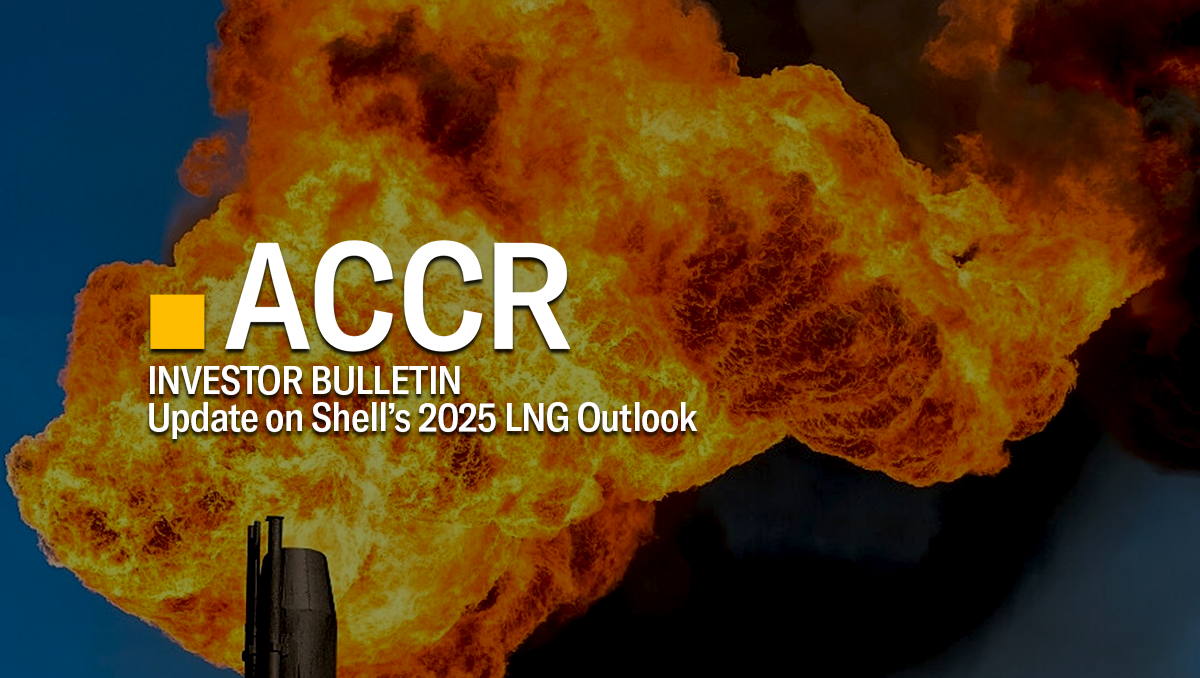Investor Insight Investor Bulletin: Update on Shell’s 2025 LNG Outlook
Shell’s LNG Outlook 2025 was released last week. It contains little to mitigate investor concerns around the bullish assumptions underpinning Shell’s liquefied natural gas (LNG) growth strategy, nor does it justify how this outlook is consistent with its climate commitments.
The upper end of Shell’s projection for LNG demand growth by 2040 has increased to 60%, up from 50% in last year’s outlook. While the demand forecast has increased, the explanation around anticipated sources of demand has shifted; away from an emphasis in the 2024 Outlook on Southeast Asian power demand growth, and towards a focus on growth in India and China for industrial and residential use.
Given Shell’s unprecedented long LNG position relative to peers, it has entrenched interests in a high demand scenario being realised. Our analysis of Shell’s 2024 LNG Outlook found instances of apparent misrepresentation of data in a direction that supports or normalises such a high demand scenario. This means the reliability of Shell’s LNG demand predictions requires particular scrutiny.
The shareholder proposal filed by Brunel Pension Partnership, Greater Manchester Pension Fund, Merseyside Pension Fund and ACCR is now even more important, as investors seek to properly appraise the risks related to Shell’s LNG portfolio, and the consistency of this strategy with company’s net zero target and stated commitment to the goals of the Paris Agreement.
As promised, ACCR will release our full analysis of the LNG Outlook 2025 in March. In the meantime, the following is an overview of our key concerns to assist investors with any engagements in the interim.
Financial risk exposure
- The high cost of LNG and how this is likely to limit demand growth is not addressed. Shell relies heavily on energy security and flexibility as key drivers of demand, disregarding competition from renewables, and the extent to which they are cheaper, lower in emissions, more modular and reduce the risks associated with a dependence on energy imports.
- The risks of Shell’s unparalleled exposure to LNG prices are not addressed.
- Shell places a misguided emphasis on biomethane and liquified synthetic gas (LSG), which would further increase lifecycle costs and wasted energy. The realisation of such an outlook depends on an overly favourable policymaking and public subsidy environment.
- Shell discloses the waning demand for long-term offtake agreements. ACCR has previously highlighted how a large proportion of offtake agreements are being signed by portfolio players, rather than actual users of LNG.
Soundness of demand predictions
The 2025 Outlook shows a change in emphasis on the key drivers of demand, compared to the 2024 Outlook. This raises a concern that Shell is building long-term strategy based on reactiveness to short term trends:
- South East Asian power demand is a much less prominent feature than in the 2024 edition. This follows ACCR research into the unattractive economics of operating LNG fuelled gas generators, compared to building new solar, in these markets.
- Our analysis of Shell’s 2024 LNG Outlook highlighted how Shell appeared to misrepresent data around the prominence of LNG in the decarbonization of Chinese steel. There are no references to the use of LNG in the Chinese steel sector in the new Outlook.
- The other point of apparent misrepresentation in Shell’s 2024 LNG Outlook was around the presentation of IEA data. Shell’s 2025 LNG Outlook makes no reference to the IEA, and instead relies on external consultants, such as WoodMackenzie.
- Chinese and Indian demand, for residential and industrial use feature more heavily in the 2025 LNG Outlook.
- Shell’s press release lists artificial intelligence as one of three key drivers of LNG demand growth, but this is not substantiated in the Outlook.
Concerns related to the Company’s unresponsiveness to changes in global energy markets are heightened. Despite evidence of energy security concerns driving down demand for LNG, Shell continues to lean on this argument as a driver of future demand.
Consistency between LNG growth strategy and climate commitments
- Shell’s forecast bets on Europe and Japan not meeting their climate commitments, and this resulting in increased LNG demand.
- The increased projection for LNG demand makes the tension between this demand projection and the Company’s net zero target even more apparent and raises questions around the feasibility of the Company meeting its climate commitments.
- Rather than increasing the transparency related to the temperature outcome of Shell’s LNG Outlook, the Company has removed any reference to the IEA scenarios, which were previously used as a means of comparison to Shell’s demand forecast.
Stewardship Questions for investors
- How does Shell justify an even greater increase in LNG demand prediction and how is this consistent with its climate commitments?
- Why has Shell removed reference to the IEA scenarios and does the company believe none of the scenarios are relevant to its transition?
- Why does Shell believe biomethane and LSG will be a part of the future energy mix, given its extremely high cost relative to energy provided and Shell’s own challenges developing hydrogen supply chains – which are arguably more cost effective than LSG?
- If LNG is key to European energy security, why did the quantity of purchase contracts signed by European customers drop so significantly?
- Why does Shell expect such strong growth in LNG supply, given the increasingly unfavourable economics of these projects in a market that is soon to be oversupplied?
Download a PDF of Investor Bulletin: Update on Shell’s 2025 LNG Outlook | 04/03/25
Please read the terms and conditions attached to the use of this site.
